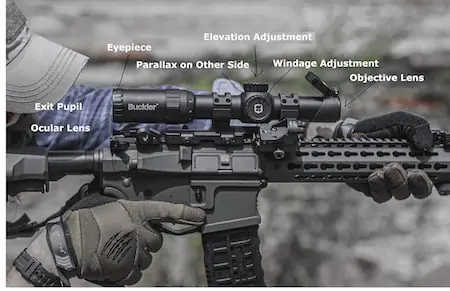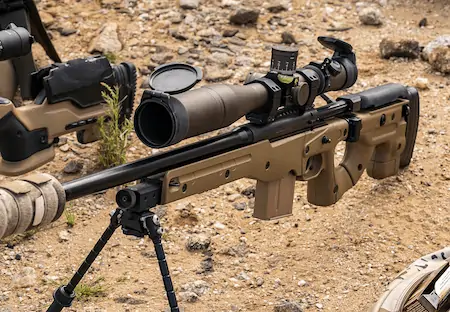When you are hunting or sniping, what mostly matters is that you hit the target with pinpoint accuracy. And in order to achieve that level of perfection, you need to go through years of practice and patience.
Scope adjustment is one of the most crucial tactics you need to learn if you want to come out as a victorious hunter. Once you achieve expertise in this aspect, you can enjoy the best results with minimal effort and time investment.
So today, in this article, we will be covering almost everything about “scope adjustment which way to turn”, so that you don’t miss even a single target while hunting.
Structure of a Scope

Before you can move on to adjusting your scope, first you have to know how the scope is structured.
Let’s talk about the parts one by one.
Objective Lens
An objective lens is the one that’s placed at the front of the scope. The purpose of it is to transmit light to the ocular lens. Make sure you always have a lens cap to protect it.
Reticle
Reticles are also called “crosshairs” that are placed for aiming. When you are hunting or shooting at an object far away, reticles play a major role in precision.
Turret
Turrets are knobs that are used for adjusting windage, elevation, and parallax. They can be capped or exposed depending on the structure of the scope.
Body
The body of the scope is the main component where all the other components are attached. It has a tube with lenses for aiming.
Magnification Adjustment
In long-range shooting, adjusting the magnification is an important strategy to make a precise shot. It’s a knob that you can turn right or left for adjusting the magnification.
Ocular Adjustment
Ocular adjustment allows you to adjust the focusing object of the crosshair. Based on the structure, the outer part or even the full ocular housing can be turned to make adjustments.
Ocular Housing
Ocular housing is the part that remains closer to your eye. It holds the ocular lens and the ocular adjustment.
Ocular Lens
This lens stays in the ocular housing. When you look through the scope, the ocular lens is the first one that is closest to your eye. Make sure you use a lens cap for protecting the lens.
Now that you know everything about the scope, let’s move on to scope adjustment and how you can do it.
Scope Adjustment Which Way to Turn
To learn how to adjust your scope and which way to turn, you have to be efficient enough to understand the key points of aiming. The points are discussed below.
#1. Turret Adjustment
As you already know, there are two knobs on your turret one is for windage adjustment, and the other one is for elevation adjustment. The windage turret will control the right and the left movement, and the elevation turret will control the up and down movement.
For easy remembering, know that the one on the right side is the windage turret, and the one on top is the elevation turret.
Turrets can be both exposed or protected with caps. The exposed ones are easy to use as they are always near to your fingers.
But, they are less protected as they don’t have any caps. Capped turrets are harder to use as you have to remove the cap first. But, they are better protected than the exposed ones.
Now, let’s see how you can adjust both types of turrets.
#2. Windage Adjustment
To fix the windage, you have to turn the windage turret on your scope. It is basically used to alter the point of impact. If you turn the turret in the right direction, your point of impact will move towards that direction, and the same happens if you turn the turret to the left.
Windage adjustment is used to control the trajectory of the bullet. It’s measured in a unit called Minute of Angles or MOA, presented in inches, and called clicks.
1 MOA is around 1.047 inches at 100 yards. It means if you turn your scope 1 MOA per click, you are adjusting your point of impact by 1 inch right or left, depending on the direction.
There’s another click measuring unit, known as MRAD. It stands for Mill Radians or MIL in short. This unit is based on the angle of a circle at the center.
No matter which unit you prefer, both your turret settings and reticle should have the same unit. Otherwise, you won’t get the precise reading for making a shot.
#3. Elevation Adjustment
Elevation turret works the same as windage turret. You just have to turn it to shift your point of impact. The difference is that instead of right and left, you’re shifting it up and down.
This turret is usually placed on top of the scope with the marks “D” and “U”, which indicates the direction.
In elevation adjustment, 1 MOA will shift your point of impact by 1 inch, up or down depending on your adjustment.
#4. Parallax Adjustment
This type of adjustment has been introduced quite recently. Shooters often faced difficulties in long-range shootings because of improper parallax adjustment. So, manufacturers started to improvise and include parallax adjustment knobs in scopes.
The term “Parallax” refers to an object’s displacement due to a shift to the viewpoint of an observer. In rifle scope, it happens when the reticle and the target are not on the same planes. If you move your eye or head around, you will find the reticle moving due to this phenomenon.
The parallax adjustment makes sure that it doesn’t happen. It’s a knob that is usually placed on the side of the scope. On some scopes, you can also find it near the objective lens.
Based on placement, side-mounted parallax adjustments are called Side Parallax or Side Focus, and the other one is called Objective Focus.
Now, to adjust the parallax, turn the knob either way and find the point where your target is on the same plane with the crosshair. When you have found the perfect point of impact, your reticle won’t cause any trouble due to different planes.
#5. Eyepiece Adjustment
One of the most frequent mistakes that a lot of hunters and shooters make is not adjusting their eyepieces on the scopes. To make sure you are properly adjusting your eyepiece, you have to understand whether your eyepiece needs adjustment or not.
If you look through your scope and find the reticle blurry but the object to be clear, then you need to adjust the eyepiece. Also, if the object is blurry but the reticle is clear, your scope needs eyepiece adjustment.
If any of these are blurry and don’t provide you a clear picture, you will be straining your eye and won’t be able to take a good shot. In long-range shooting, having a clear target and reticle is equally important.
Eyepiece adjustment on your scope is quite easy and simple. At first, place a paper a few feet away from your scope.
Set your aim at the paper and keep looking at it through your scope for a few seconds. Now, adjust your focus to make sure you have a clear picture. Let your eyes rest a bit by closing them and repeat the strategy.
Keep doing this until you find a clear reticle while aiming down for a few seconds. If your eyepiece is properly adjusted, the reticle won’t be blurry even if you look through the scope for a while.
Zeroing Your Scope
You might need to make quite a few adjustments to your scope before hunting or shooting.
But, if you are going to use the same scope in a different rifle, you have to bring the settings to factory settings so that you can adjust them depending on the rifle’s requirements. So, how to zero-reset your scope? There are two ways you can do it.
Aim at a mirror and look through the scope for a while. If the optic is centered, you will only be able to see the crosshair. If it has been customized, you will be able to see the crosshair’s shadow on the mirror as well. Keep adjusting the scope until you don’t see the shadow on the mirror.
To follow the second method, keep winding the turret in any direction to all the way it goes, and then turn it back to the other side as it goes. In the second turning, count the click numbers.
Now, divide the clicks in half and turn the turret to that number of clicks. You will now have a centered turret that has been zeroed.
Frequently Asked Questions
#1. How to identify the different types of turrets?
The turret on top is the elevation adjustment turret. There are two turrets on both sides. One on the right is the windage turret, and the other one on the left is the parallax adjustment turret.
#2. How to identify the lenses on a scope?
The one closest to your eye is the ocular lens. And the one furthest away is called the objective lens.
#3. How to know if I have proper parallax adjustment?
When you will see that your reticle is on the same plane with your target, you will know that you don’t have any parallax and are ready to take a shot.
Conclusion
No matter how advanced your rifle is, if your scope is not properly adjusted, you won’t be able to make precise shots.
Scope manufacturers have worked tirelessly to make sure that shooters can easily adjust their scopes. So, try to learn everything about scope adjustment which way to turn, and don’t miss a shot anymore!


